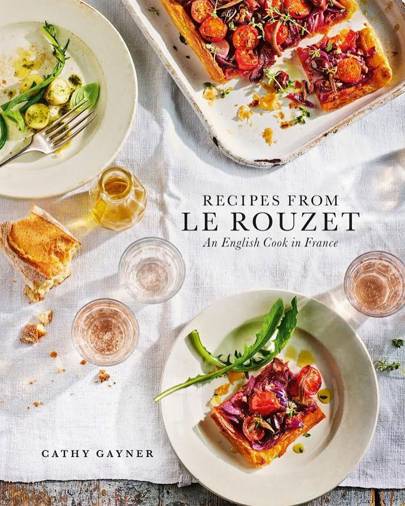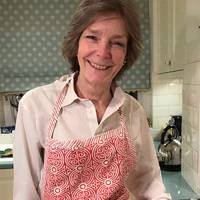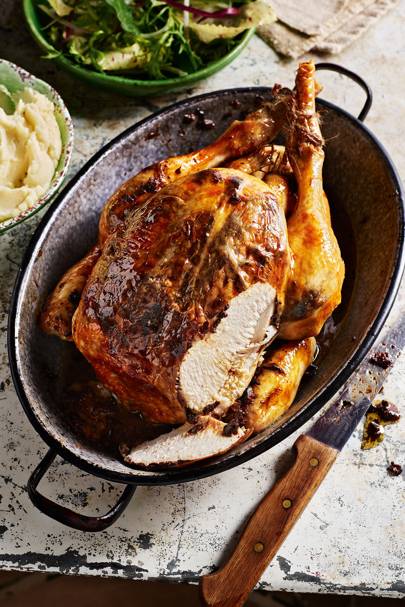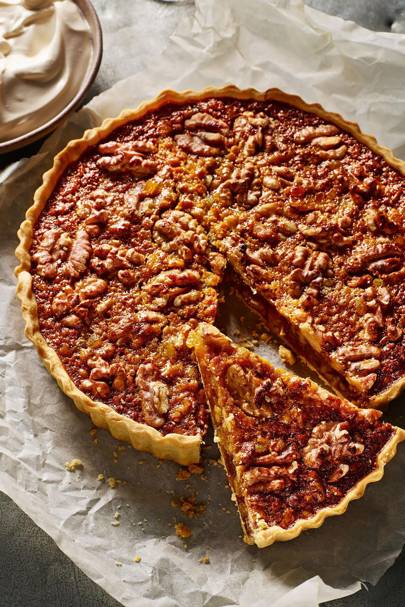
Recipes From Le Rouzet: An English Cook in France by Cathy Gayner
Instagram: @jamesmurphyphoto
The story behind Recipes From Le Rouzet: An English Cook in France is a charming one. And it seems all the more romantic after the gloomy lockdown winter we’ve just had, spent cooped up indoors, dreaming of happier days and sunnier climes.
The book is the first recipe collection from Cathy Gayner, founder of Age Unlimited, a charity that provides support to two vulnerable age groups: the vulnerable elderly and marginalised young people. While these demographics were already facing significant hardships, from loneliness to financial insecurity, such issues have been exacerbated yet further by the pandemic, rendering Age Unlimited’s work all the more vital right now.
Talking exclusively to Tatler, Cathy relates that it was her nephew, Justin Gayner, one of Age Unlimited’s trustees, who convinced her to embark on the cookbook. Justin – who Cathy dubs ‘a supremely greedy person, which is lovely’ – spent many of his childhood summers at Le Rouzet, his aunt and uncle’s French summer home, being cooked for by Cathy. She had promised that one day she’d write down her recipes for him. ‘And then when he became a trustee he said to me, “If you did it for the charity, it would make you do it”.’ She liked the idea of ‘a book for our lovely supporters – and so I was sort of catapulted into it,’ she recalls.
Cathy clearly remembers the first time she set eyes on Le Rouzet – and her future husband – some 50 years ago. The property was then little more than a collection of rambling, run-down farm buildings, and Cathy herself just a teenager. She recalls, ‘When I turned up at Le Rouzet with a whole bunch of friends who knew Richard – and who knew that if we did a day’s work he’d give us a roof over our heads – I couldn’t cook for love nor money.’

Cathy Gayner
Instagram: @ageunlimited
Cathy is the granddaughter of Cecil Harmsworth King, former Chairman of the International Publishing Corporation, an influential figure in English media landscape who makes an appearance in Season 3 of The Crown. Her great uncles were British newspaper titans Viscount Northcliffe and Viscount Rothermere, and her father was St John Gore, a respected art historian and an adviser on pictures to the National Trust. ‘My father really couldn’t cook to save his life,’ Cathy remembers. ‘A very erudite, scholarly man, but cooking didn’t feature.’ Her mother, meanwhile, ‘had scarpered – needless to say with all the cookery books,’ so cooking was, she explains, ‘far away from anything I’d ever dreamt of.’
While her upbringing may not have involved much schooling in the domestic arts, all that changed after Cathy’s arrival at Le Rouzet, where she was destined to be far more than a fleeting visitor. Romance blossomed with Richard, and ‘within a year I had had to learn to cook,’ she recalls. ‘And so it’s just evolved over all those years, first catering for huge numbers of friends of Richard’s putting on roofs, then hungry hoards of small boys, and obviously lots of guests… It’s about cooking, that house really.’
Over many summers spent at Le Rouzet, Cathy has developed a veritable treasure trove of recipes, with a focus on low effort, high-impact dishes that can be whipped up with minimal time and fuss. When her sons were children, ‘they would invite all of their friends through the summer and we would have literally 20, 30 little boys to feed. So you had to become a very quick cook, and if there was a way of cutting a corner, you’d cut it.’
While the numbers may have been less staggering when Cathy was cooking for adult house guests, the same principles applied: ‘When people come to stay, I don’t think there’s anything worse than having your hostess in the kitchen the whole time, because you just feel guilty. So these recipes are based around that premise; if you have a house party of 10 or 12 and you have to produce food without being seen to be in the kitchen… It’s trying not to look like a harassed hostess. And to look as if you’ve done something without having done much.’
In fact, contrary to the idea of French food as complicated and elaborate, this style of cooking was a natural fit at Le Rouzet. Cathy notes: ‘Because I’ve never been on a cookery course in my life and didn’t have any training, I don’t think I went to Le Rouzet thinking, “Right, we ought to be making coq au vin… and rich Gruyère and cream sauces”.’ Which is lucky, she jokes, since ‘round us in south west France, you couldn’t get cream for love nor money… In a small village, you cook with what you’ve got.’
Hence while there’s ‘nothing classical’ about Cathy’s recipes, the dishes have ‘a very French feel, because it’s still very difficult to buy anything even Italian or Spanish there… It’s a bit of a mongrel of a cookery book, in that it’s food in France, but it’s not necessarily French food.’ This has made the recipes mercifully accessible and approachable, with Cathy stressing that there are ‘no clever ingredients’, adding: ‘One of the things that puts me off a recipe is if there’s a huge long list of things that you’ve got to have to hand to make it.’
When it came to putting together the book, Cathy relates that narrowing down her ‘reams and reams’ of recipes to the final 125 was ‘extremely difficult’. ‘But I asked the greedy Justin and my equally greedy family what they considered the essential recipes, so they all helped choose,’ she explains. ‘And then I love puddings, so some were put in because I’ve got a sweet tooth. And some were put in by me out of pure nostalgia, actually.’ Take the recipe for some ‘amazingly simple water biscuits’, which even Cathy’s cooking-novice father was able to make: ‘When I was expecting John [one of her sons] and feeling dreadful, he remembered his nanny had made him water biscuits. Then he made them for me all the way through my pregnancy. They are utterly delicious with cheese.’
As for how she made the transition from home cook to a published food writer (with all the rigour and precision that entails), Cathy says that she’s ‘a fairly pernickety character – I was a calligrapher and you have to be absolutely accurate about everything – so it sort of came naturally.’ Just as she began to work on the book, however, ‘two days later we had a spectacular flood – and so I had no kitchen for 16 months.’ Yet she adds: ‘Actually it was probably the best thing that could have happened to me, because it made me really look at the recipes in minute detail… How many grinds of pepper? How much is a pinch?’
Cathy is also full of praise for the ‘amazingly brilliant’, James Murphy, a renowned food photographer who has shot the likes of Rick Stein’s recipe books, Gregg and Anna Wallace’s Italian Family Cookbook, the Riverfood Organic Cooking with a Veg Box series, and tomes from acclaimed restaurants Berber & Q and Mosimann’s. On being approached about a project in aid of Age Unlimited, Cathy recalls that James ‘rang and said, “I’d really like to do it as my contribution to the charity, I’ll do it for free”.’ She reflects on the devastating impact the pandemic has had on charities, noting, It’s been a non-starter for the last year, so sitting and writing the cookery book was very therapeutic. It made me feel as if I was doing something.’
Humble as she may be, Cathy’s recipes – including tempting dishes like red onion tarte tatin; marinated figs with Camembert; confit duck legs with chorizo; and honeycomb ice cream – have won praise from some of the most respected names in the food industry. Rick Stein says the book sparks ‘delightful anticipation, totally justified by cooking some of the dishes’, Alain Roux describes it as a ‘lovely book for a worthy cause, marrying the very best of Britain and France’, while Thomasina Miers deems it ‘simple and delicious… with sumptuous recipes and photography’.
Now that we’re all looking forward to gathering with friends and family – hosting them for long-awaited summer lunches and dinner parties once again – Cathy reflects on the sad fact that not everyone will be so lucky. On her work with Age Unlimited, she explains that ‘until you start working in these sectors you don’t think about it. You take it for granted, “Everybody has a kitchen table.” Well, they don’t. And you think everybody’s got a cupboard with something to eat in it, and they don’t.’
Cathy laments ‘this terrible thing of people not having family or friends to sit round with, or not even having a table… It’s where you get a moment to talk, to sort out the family’s problems, where you have a happy time.’ This was brought home to Cathy even more after her own home flooded: ‘One of the things about not having a house for the last 18 months – and certainly not having a kitchen – was the inability to sit with friends and family around our kitchen table. And I missed it so much… So writing a book like this makes me think, “Look how lucky I am”.’
As we look forward to gathering with friends and family again – ‘Wouldn’t it be nice!’, Cathy enthuses – she reflects: ‘To me, cooking is therapy, because it’s doing something for other people, the house smells wonderful… it’s a lovely, lovely thing to be able to do… I just can’t wait to get back to real life, can you?’
Read on for a sneak preview of two mouthwatering recipes from the book
Chicken Stuffed with Tapenade

Chicken Stuffed with Tapenade
James Murphy
Serves 4
If you are a purist you can make the tapenade yourself, but then the dish becomes more time consuming – and the point of it is that it is quick and easy. This is also very good cold.
- 1 pot of tapenade
- zest and juice of 1 lemon
- 1 garlic clove, crushed
- 1 tbsp chopped parsley
- 1 really good chicken
- 1 tbsp olive oil
- salt and pepper
Mix the tapenade with the lemon zest, garlic and parsley.
Using your fingers, gently separate the skin from the flesh of the chicken and spoon in the tapenade mixture. Ideally, push it down both the breast and the legs; this is fiddly but not difficult.
Season the skin and pour over the oil and the lemon juice.
Roast at 200°C/Fan 180°C/Gas 6 for 20 minutes per 500g, plus 20 minutes extra.
Serve with mashed potato and the juices.
A simple green salad is the only other thing you need.
Walnut Tart

Walnut Tart
James Murphy
Serves 4 generously
This is very much a part of Le Rouzet menus in the early autumn, when our walnuts are beginning to ripen and every tree seems to have a red squirrel perched in it, noisily eating our supply. It’s like a sophisticated treacle tart, but not heavy, and is really worth making even if you don’t have large quantities of walnuts to use up.
Pastry
- 110g butter
- 140g flour
- 30g icing sugar
Filling
- 20g butter
- 200g golden syrup
- 100g walnut halves
- a pinch of mixed spice
- 100g mixed peel
- 4 madeleines (or soft amaretti), crumbled
- 1 egg, beaten
Put all the ingredients for the pastry into a food processor and mix until the dough forms a ball. Press the dough into a 20cm tart tin with a removable base. Prick the pastry all over really thoroughly, even up the sides (this will prevent shrinkage), then chill in the fridge.
Cook in a preheated oven at 180°C/Fan 160°C/Gas 4 for 15 minutes or until golden.
Melt the butter and syrup in a pan and stir in all the other ingredients. Pour into the pastry case and cook at 190°C/Fan 170°C/Gas 5 for 15 minutes.
Cool in the tin but as soon as you can, loosen the edges of the tart or it will get stuck.
Serve with crème fraîche.
Recipes From Le Rouzet: An English Cook in France – RRP £19.99 (including P&P). 100 per cent of the proceeds raised will go directly to Age Unlimited. Order at cathygayner.com
Subscribe now to get 3 issues of Tatler for just £1, plus free home delivery and free instant access to the digital editions
More from Tatler
Article From & Read More ( Recipes From Le Rouzet: An English Cook in France charity cookbook Age Unlimited recipes - Tatler )https://ift.tt/3a5gnpZ
Tidak ada komentar:
Posting Komentar